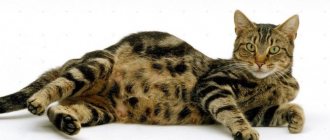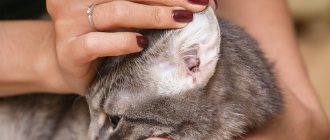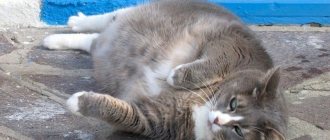Causes
There are a huge number of reasons that provoke such a painful condition. Disturbances in the functioning of the body can occur both due to poor nutrition and genetic abnormalities. However, the most common reasons can still be identified:
- hormonal disorders or hormonal changes;
- poor living conditions;
- poor nutrition;
- failure of the endocrine system;
- decreased immunity
- presence of chronic diseases;
- parasites of internal organs.
Vomiting also occurs against the background of the death of offspring. Injuries, bruises, harmful substances, poisons and much more have an extremely negative impact on intrauterine development. If the kittens die, a miscarriage occurs.
Genetic abnormalities often cause toxicosis in cats during pregnancy. Siamese, Abyssinian, Bombay breeds are susceptible to it, and a similar condition is also observed in Devon Rex and their mixed breeds.
What to do?
Help your cat survive 10 days of discomfort, perhaps by following simple rules:
- Ensure complete rest. During sleep, immune defenses are restored. Restful sleep reduces the risk of contracting diseases during such a difficult period.
- Comfortable conditions. The animal may be nervous, it is important to support the pet, calm it down and pay attention to it.
- Nutrition. There is no need to force people to eat; it is better to offer several types of foods to choose from. It is better to reduce the portion size and increase the number of meals. Water or milk should be available at all times.
It is important to understand that the use of medications for pregnant women is prohibited. If the development of toxicosis occurs against the background of chronic pathology, treatment should only be prescribed by a specialist. You should not resort to self-medication; such a thoughtless approach can only provoke a complication that will negatively affect the cat’s health, but also cause pathological abnormalities in the intrauterine development of the fetus.
Signs
Pregnancy in domestic cats lasts 9 weeks, which are usually divided into trimesters. Most often, the painful condition manifests itself in the first trimester, after 3-4 weeks. It is one of the first signs of pregnancy in a cat and lasts up to 10 days. Cases of vomiting in late stages are extremely rare.
The most striking symptom of toxicosis is nausea. It occurs in the morning, after eating. The pet becomes lethargic, its mood is close to depressive: apathetic, drowsy. Aggressive behavior is also possible. She may, on the contrary, become more affectionate: often demand attention and communication.
The expectant mother's taste preferences change. She refuses food or treats that she readily ate before pregnancy. Disorders of the digestive system are possible, which ultimately leads to diarrhea.
Course of pregnancy
During the entire period of gestation, the animal must be under the constant supervision of a doctor and owner.
The usual physiological process of development of a fertilized egg in a cat’s body lasts from 55 to 63 days. This period is influenced by the breed of the animal and the number of kittens that should be born. Only a pregnancy with a large number of fetuses can reduce the gestation time. The picture of the development of the special state of the animal is as follows:
If the mating is successful, then the first few weeks for the animal become more drowsy.
- In the first 3 weeks, behavior changes: the cat sleeps a lot of time, eats more and moves less. Closer to 21 days, the nipples swell and become pink.
- During 4-6 weeks, characteristic features of pregnancy appear. The belly gradually becomes rounder, and after 40 days it begins to grow rapidly. During this period, the veterinarian can feel the number of embryos.
- At 7-9 weeks, the cat's appetite decreases, but she still sleeps a lot. If you put your hand on your stomach you can feel the babies moving. The closer the 63rd day, the lower the stomach drops (located in the hip area). The animal does not leave its owner, but at the same time is looking for a place to build a nest for its offspring.
Visible symptoms
The fact that a cat is pregnant can be assumed by changes in its character and behavior; only a veterinarian can make an accurate diagnosis. There are no obvious symptoms to be noticed immediately after mating; the first characteristic signs that will indicate the imminent appearance of kittens will appear after fertilization only after 3 weeks. The following visible, distinctive signs are distinguished:
A manifestation of this condition in an animal is an enlargement of the mammary glands.
- enlarged mammary glands;
- low physical activity;
- lethargy and drowsiness;
- lack or increase in appetite;
- change in taste preferences.
Should I worry?
If toxicosis is mild, then there is no need to focus on it. Nausea is short-term and will disappear on its own in a few days. But if attacks of vomiting are accompanied by unnatural symptoms, then this is already a cause for concern.
Dehydration indicates that your pet has poisoning or kidney failure. Impaired kidney function makes it difficult to eliminate harmful substances, which means that some of the toxins will be absorbed by the offspring. The main signs of dehydration are a dry mouth and a dull, dull coat.
Low temperature readings can indicate not only intoxication of the body. Sometimes this signals that the pregnancy is fading.
Diarrhea can also occur due to poisoning. However, stool disorders are observed with intestinal infections, colds, and damage to the tissues of the digestive organs. Diarrhea is dangerous because it can cause miscarriage.
Other signs that indicate problems include:
- vomiting too often;
- complete refusal of food and water;
- dyspnea;
- heart rhythm is disturbed;
- muscle pain.
Why is it dangerous?
A minor physiological disorder develops slowly, without causing harm to the animal or embryos, and disappears just as slowly. If the development of pregnancy is accompanied by a rapidly deteriorating health condition caused by severe intoxication, an urgent need to respond, since such a situation is dangerous for the life of the pet and small kittens. Worrying signs that are not typical for toxicosis should cause concern:
The accompanying decrease in the pet's temperature is dangerous for the life of her offspring.
- Sudden drop in body temperature. Leads to a slowdown in life processes, which in the early stages can result in the “fading” of the fetus.
- Disorder. Diarrhea caused by poisoning, an intestinal virus or a cold leads to miscarriage.
- Loss of large amounts of fluid. Increased intoxication of the body primarily negatively affects kittens.
When danger threatens
It is important! The pet must be urgently shown to the veterinarian if she has toxicosis in the later stages or before giving birth. This indicates pathology. There is a risk of death not only of the offspring, but also of the expectant mother.
As a rule, a cat with late stages of intoxication is immediately detoxified. Waiting for test results is very dangerous, since hours and even minutes are counted. The further course of treatment directly depends on the condition of the expectant mother and her offspring. If the kittens are full term, a caesarean section is performed. In other aspects, veterinarians try to support the patient until the moment of birth.
Age and characteristics of puberty
Cats live in the wild for up to five to eight years, and with good care near humans they can live up to seventeen to twenty. Long-living record holders celebrated up to thirty birthdays. At the same time, initially the body of female small cats is created in such a way as to prepare for the first pregnancy at a young age: approximately 5-7 months, depending on the breed. Small cats, such as Siamese and Orientals, mature earlier, large cats - British cats, Maine Coons - later. It is not difficult for the owner to guess whether the “girl” is ready for mating, since behavioral patterns change dramatically:
- A few days before the first heat, the cat becomes more affectionate and clings to its owner. This change can be especially noticeable in independent animals, which are usually not prone to excessive expression of their feelings.
- Some individuals begin to mark their territory with urine. This problem is less pronounced in females than in males, but is also quite common, especially if there is more than one animal in the house. In this way, the cat shows its readiness to mate and its place in the hierarchy.
- As soon as the “rut” period begins, the cat’s behavior changes even more. She begins to meow protractedly, announcing to all the surrounding cats that she is ready to become pregnant.
- Many young pussies feel bad during heat, they seek help from the owner, and become overly affectionate. Scientists believe that they suffer from painful sensations.
- If fertilization occurs, estrus stops after a day or two. Sometimes this time is enough for the female to be attracted to another cat, as a result of which cats can become pregnant with several males.
This is due to the fact that although the first heat occurs in cats at a young age, they are still too young, and their bodies are fragile. The offspring of such animals are weak and often non-viable. The young mother herself also suffers from too early pregnancy, and may even die in childbirth.
How to avoid diarrhea during pregnancy, how and how to protect yourself?
Following these 5 simple rules will greatly reduce the likelihood of diarrhea during pregnancy.
- Don't forget about personal hygiene - wash your hands before eating. Do not consume expired products;
- Do not eat in establishments with a dubious reputation;
- Do not eat food that is not the first freshness;
- Don't overeat;
- When planning a pregnancy, treat chronic diseases.
And one more thing: we all carry a mobile phone with us everywhere. According to the rule of etiquette, on which side of the plate should it be? Jokes aside, as a result of a recent study, scientists found that every sixth phone contains E. coli - bacteria that live in feces. E. coli “with a slight movement of the hand” moves to your plate! There is only one conclusion - wash your hands after visiting the toilet!
Health to you and your baby!
Preparing for childbirth
In most cases, cats independently prepare for childbirth, starting to do this especially actively from about 7 weeks of pregnancy. This is expressed in finding a quiet and secluded place, arranging some kind of nest by dragging soft rags, etc.
A person can help his pet in the following ways:
- From about the middle of pregnancy, provide the cat with a box or bed, place it in a remote place and line it with something soft. Immediately begin to accustom the animal to this place, periodically putting it down and rewarding it.
- 2 weeks before the expected birth, try to provide your cat with a calm environment so that she does not try to escape or isolate herself.
- If there are children at home, you should consider giving the cat a separate room for a while, which is especially important in the last 14 days of gestation.
Important!
In more than 90% of cases, labor in cats occurs without problems and without the need for human intervention. If you are still too worried, it may make sense to call a specialist at home.
Prenatal checkup
The examination should be carried out by a veterinarian several times throughout the pregnancy. This allows you to monitor the condition of the animal and respond in time to any problems if they arise.
After the examination, the doctor gives the owners a number of instructions, for example:
- ban on the use of anthelmintic drugs;
- ban on the use of flea products;
- recommendations for preparing a diet;
- recommendations for reducing cat activity in the last weeks before giving birth, etc.
We advise you to find out in advance where and how to seek veterinary help if an unforeseen situation arises.
Second trimester
Doctors call this period the “golden” period of pregnancy. As hormonal changes occur and the body adapts to its new position, nausea and vomiting disappear, and the woman feels a surge of strength and energy. How's the baby? During the first three months of intrauterine development, all organs of a child are formed and functioning. In the second trimester, a period of intensive growth and development of the little man begins.
But the joy of the expectant mother can be marred not by an increase in waist size, but by heartburn, constipation, and diarrhea during pregnancy in the second trimester.
With diarrhea, a large amount of fluid and microelements is lost, which leads to dehydration and lack of nutrients, and impaired fetal development. If you are concerned about this, a pregnant woman should contact her doctor.











